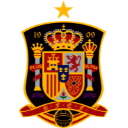
The history of the Spain national team's kit has undergone many changes over the years, reflecting the changing trends and styles in football fashion. The traditional colors of the Spanish national team are red and yellow, and these colors are always used in the design of their kits.
In the early years, Spain's kit featured a plain red shirt with blue shorts and black socks. The design remained relatively simple until the 1920s, when the team introduced a stylized symbol of the Spanish flag on the jersey. The emblem is red and yellow, representing the Spanish flag. During the 1960s and 1970s, Spain's home kit underwent significant changes. The team experimented with different shades of red and introduced striking yellow/gold stripes on shirts and shorts. The design became iconic and often associated with the success of Spain during this period.
During the 1980s and 1990s, Spain's kits took further developments. The gold/gold stripes are still retained, but the patterns become more modern and elegant. Spain sometimes introduce variations of their traditional colors, such as darker reds or all-red kits for specific matches.
One of the most important moments in the history of the Spain kit came in the early 2010s, during their successful period winning major international tournaments. Spain, meanwhile, wore a simple, classic football kit with a red shirt and gold accents, teamed with blue shorts and black socks. The football kit features Adidas' signature three stripes on the sleeves.
In recent years, Spain's kits have continued to evolve with advancements in fabric technology, providing players with more comfortable and functional clothing on the pitch. The team introduced modern designs with subtle details that pay homage to the country's rich football heritage.
As with most national teams, sponsor logos are also displayed on Spain's kits, providing essential financial support to the team.
Overall, the history of Spain's kits is marked by a mix of traditional colors and modern designs. The red and yellow colors remain unchanged, representing the pride, passion and identity of the Spanish national team as they continue to compete at the highest level of international football.
In the early years, Spain's kit featured a plain red shirt with blue shorts and black socks. The design remained relatively simple until the 1920s, when the team introduced a stylized symbol of the Spanish flag on the jersey. The emblem is red and yellow, representing the Spanish flag. During the 1960s and 1970s, Spain's home kit underwent significant changes. The team experimented with different shades of red and introduced striking yellow/gold stripes on shirts and shorts. The design became iconic and often associated with the success of Spain during this period.
During the 1980s and 1990s, Spain's kits took further developments. The gold/gold stripes are still retained, but the patterns become more modern and elegant. Spain sometimes introduce variations of their traditional colors, such as darker reds or all-red kits for specific matches.
One of the most important moments in the history of the Spain kit came in the early 2010s, during their successful period winning major international tournaments. Spain, meanwhile, wore a simple, classic football kit with a red shirt and gold accents, teamed with blue shorts and black socks. The football kit features Adidas' signature three stripes on the sleeves.
In recent years, Spain's kits have continued to evolve with advancements in fabric technology, providing players with more comfortable and functional clothing on the pitch. The team introduced modern designs with subtle details that pay homage to the country's rich football heritage.
As with most national teams, sponsor logos are also displayed on Spain's kits, providing essential financial support to the team.
Overall, the history of Spain's kits is marked by a mix of traditional colors and modern designs. The red and yellow colors remain unchanged, representing the pride, passion and identity of the Spanish national team as they continue to compete at the highest level of international football.

